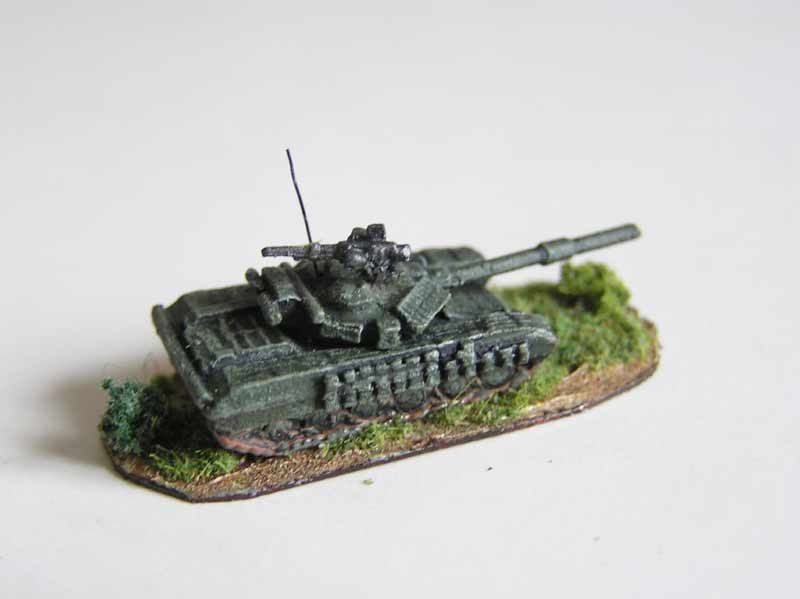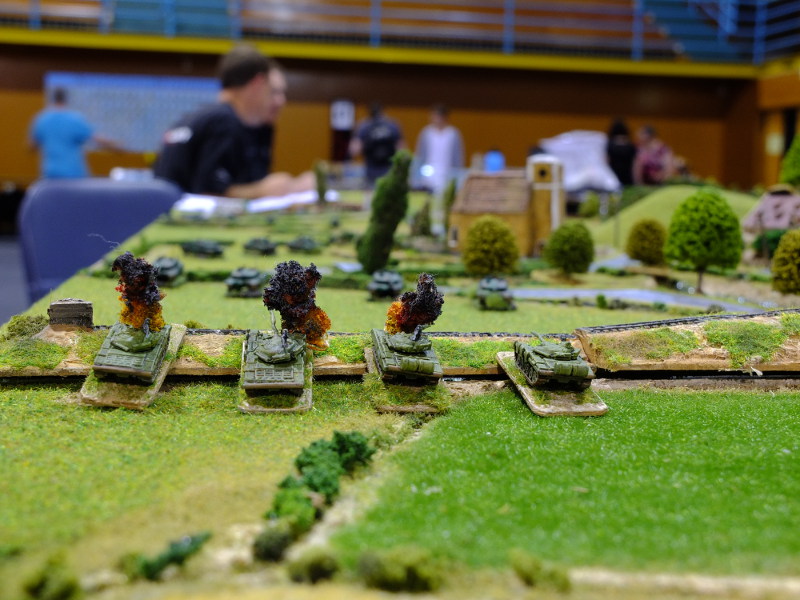 |
| Soviet T64BV column advance through streets of German city |
1st alternative was Able Archer which we played two weeks ago but now we tried Sabre Squadron rapid deployment rules.
I had Soviet T64BV tank company supported by BTR70 mounted infantry platoon, BRDM2 section and PT76b recce platoon. my Company engaged British reinforced tank company in streets of unknown city 4 platoons worth of Cheftians supported by swingfire detachment and two infantry platoons mounted in FV432.
There were some mistakes i made and in middle of game i realised this game plays different than most systems that i played but while i took some loses in mid-game i created some heavy headache to british knocking down 2 tank platoons,destroying swingfire and knocking out FV432s mainly because well laid ambush. We played pitched battle with no real objectives but that would we change since i will order full rules very soon because me, British player and US player (which was only observing)
like them.
So now lets run to basics the system is IGOYGO system and each player turn is divided into for phases. In first phase active player activate his units giving certain orders:
Units can either Fire then move. Move fast (but then their can be more easily hit). Move and fire (here matters if you have stabilised or unstabilised gun how far you can move). Normal move without fire. or remain stationary and fire (you have bonus for fire since you, but so does have your enemy shooting back at you)
Of course combat is about skill and morale and that really matters in Sabre Squadron, it matters if you shoot or shoot upon. morale grade also how your units will keep their heads cool if you start taking losses.
Movement is pretty straightforward and IMHO its very good each vehicle have number of bounds depending on terrain in which it moves if you move through different types of terrain you use the worst number of bounds. each type have also lenght of its bound for example fast tracked tank moves 2 and half inch in one bound. In cross country it can move 4 bounds (meaning it can move 10" while if it will be traveling through some difficult terrain it can move only two bounds (5") crossing minor obstacles cost also bounds depending on obstacle and type of your mobility type.
Shooting is very nice with rolling 1D10 where you had to score 5 adding modiferes, there are quiet a few modiferers but i think they are easy to remember- for example there is modifirer for shoting at target which was not in LOS at the start of unit activation, for long range (most of heavy weapons dont have maximum range), if you dodge ATGM missle and so on. ATGM have of course maximum and optimal range firing they can relativly easily hit but enemy can dodge them (and if the missle is comming from front their chances to dodge are much better) when enemy is hit he D10 and depending on roll his basic defense is lowered or raised by one or two or in case 5-6 it remains same. Most of vehicles have two defense ratings, Kinetic and Chemical Energy, as well as weapons can have different values of K and CE attacks. When enemy is struck you compare modified armor againts firepower of shooter the outcomes are easy FP same as armour vehicle is supressed and cannot use its weapons than exposes the crew. Firepower is better than armour by one the vehicle is neutralised. the vehicle can be knocked out, or crew is stunned by shot at end of the turn you test this neutralised vehicles they got save roll and are either destroyed or supressed. if the the firepower is better by two or more points target is destroyed. Hiting infantry is little different but disloging infantry from cover especialy if is in mason buildings or dig in is very hard. While pinned vehicles arent much problem, if your infantry is pinned they move slower and their accuracy is low.
There are rules from close combat which is very deadly and quick. also Artillery have interesting rules, hitting very large area but you need really big guns to be sure about deadly effect.
 Command and Control rules are written strangely in Rapid Deployment but i think i get them right - coherency is measured by type of unit platoons uses 2 A4 papers while indepenedent section and low trained platoons only 1, that is their coherency.
Command and Control rules are written strangely in Rapid Deployment but i think i get them right - coherency is measured by type of unit platoons uses 2 A4 papers while indepenedent section and low trained platoons only 1, that is their coherency. As forces start taking loses they morale will be affected to represent this game simulate this is relativly simple but effective manner. If scenario dont dictate otherwise the units begin their game as Good but when morale test is called unit must pass morale test (depending on how much loses units get modiferer to roll) if they pass good nothing happens. but if they fail they morale level drops and they roll again until they rout or pass test. if level is good units act as normal,
the level lower is uncertain unit which wants to move toward enemy baseline or forces must pass morale test.
next is halt which means the units wont advance until their morale is raised up. then is withdraw toward their own baseline and takeup cover if possible. last is rout - the unit has been demoralised and for game purposes is destroyed.
The morale can be raised by one level at the end of the turn - if unit hasn´t been target by enemy actions (direct fire, assault, arty fire) by passing morale test.
Each force has breaking point - number of losses before it render itself combat ineffective - if it exceed 2/3 of its number Morale points the forces withdraw and losses.
The Rapid Deployment rules was big suprise for me , and we enjoy the game. Stay tunned i will review full version soon



















